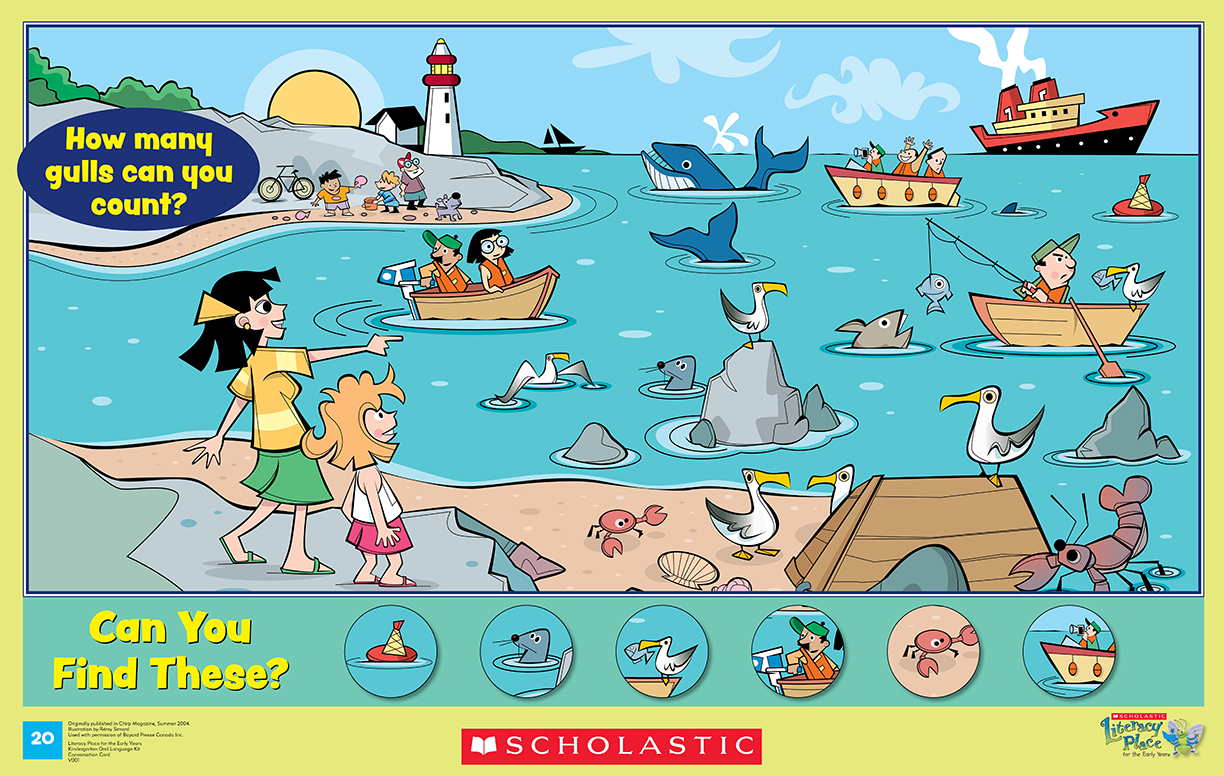Oral Language Teaching Strategy:
Model Good Language Use Clarify and model good language use, without correcting, when individuals need support.
Time:
one 30-minute lesson or two 15-minute lessons
Materials: I-Spy Card #20
Grouping: whole class or small group
Assessment:
Kindergarten Oral Language Assessment Scale
FOCUSING ON THE PICTURE
[Analyzing/inferring]- Show students the picture. Ask them to look at it and think about the place they see. Discuss any vocabulary that may be unfamiliar with students (crab, buoy, oar, gull).
- Draw students’ attention to the blue oval with the question inside. Read the question “How many gulls can you count?” Discuss what a gull is then ask students to count the gulls silently. When they have an answer, ask them to hold up their fingers to show how many gulls they found. Invite individual students to describe the location of a gull until all six gulls have been located.
Sasha: The one that’s gots a fish in their mouth.
Teacher: That’s right. There is one that has a fish in its beak.
- Discuss the features of an ‘I-Spy’ text by asking students if they have seen any ‘I-Spy’ books before. Tell them that the smaller pictures at the bottom of the card can be found in the larger picture. Invite students to locate these pictures shown along the bottom of the card with a partner. Students could find these items independently and then take turns describing the locations to a partner.
- Provide time for partner discussion and invite a few partners to share their thinking with the group.
- Offer the following prompts to stimulate discussion:
- Where does this scene take place?
- What type of day is it? What clues from the picture tell you that?
- What season or time of year is it? Why do you think that?
Teaching Tip: Invite students to name other objects and animals they see in the picture. This will provide opportunities to model good language use.
GOING DEEPER
[Inferring/evaluating]- Offer prompts that focus on the actions in the scene:
- What are the people in the picture doing?
- How are the people feeling? Who is having a good time?
- Everyone in the picture seems to be looking at something. What do you think they are each watching?
- Find someone who looks excited or upset in the picture. Why do you think they are feeling this way?
- Provide the beginning of a character’s dialogue and ask students to complete the sentence, e.g., If I were the man fishing in the boat I might say, “Seagull, I want….
Teaching Tip: Notice students’ use of pronouns and verb tenses. If students make grammatical errors, repeat back their sentence using correct language structures. For example, if a student says, “Him sees the whale splash.” Repeat back, “Yes, he saw the whale splash, didn’t he?” Avoid correcting students; instead, give them opportunities to hear correct grammatical structures in your speech.
You may conclude the lesson at this point and do the second part on the next day, or you may decide to continue and do Connecting and Predicting as part of the first lesson.
CONNECTING
Teaching Tip: If you decide to do Connecting and Predicting on the second day, begin your lesson by reviewing the picture with the students.
[Making connections]- Connect to students’ prior experiences by discussing summer activities:
- Find something in the picture that you have done before, or would like to do, and tell your partner.
- Is there another activity you would like to add to the picture?
- Think about where we live. What summer activities can we do in our community?
-
What did you do when you went to a beach? What did you find there?
Offer specific prompts that fit the discussion you have had with the group.
PREDICTING
[Predicting]- Ask students to think about how this scene would change if it showed another time of the day or another time of the year. Record their ideas on chart paper.
-
What do you think will happen? What makes you think that way?
Choose one of the scenarios in the picture, like the three men in the boat, and ask the students what they think the men will do next. Ask students to choose another character and tell a partner what they think will happen next. Invite a few students to share their ideas with the group.
LESSON EXTENSIONS
- Use a specific scenario from the picture as the basis for a shared writing lesson. Brainstorm ideas with students and together write two or three sentences to describe the activity shown in the scenario.
-
Choose a character from the scene and write a modelled writing lesson using the format of a journal entry to describe the character’s day at the beach.
-
Use the shared writing and modelled writing lessons as shared reading texts and reread them with the students.
FOLLOW-UP IN CENTRES
- At the art centre students can illustrate a favourite summer activity and write a sentence to describe the activity. Have students explain their illustration to you or another student.
- Display the card at the math centre and invite students to create new counting tasks for the picture with a partner. Model this ahead of time: “How many boats can you count?” Then ask a student to count the boats. Have partners take turns at asking the questions and counting. Challenge students to create questions that require students to categorize, for example, “How many different types of animals are there in this picture?”
- Display the card at the art centre and invite students to add to the ‘Can You Find These?’ activities by selecting another object from the picture, tracing it, and asking a partner to locate it in the picture.
- At the writing centre have students write a journal entry to describe a day at the beach from the perspective of one of the characters in the picture.

